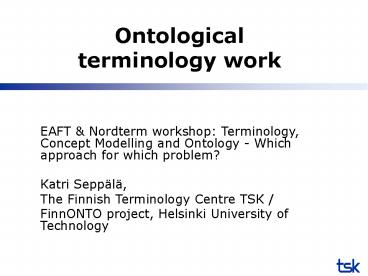Ontological terminology work
Title: Ontological terminology work
1
Ontologicalterminology work
- EAFT Nordterm workshop Terminology, Concept
Modelling and Ontology - Which approach for which
problem? - Katri Seppälä,
- The Finnish Terminology Centre TSK /
- FinnONTO project, Helsinki University of
Technology
2
Ontological terminology work
- Contents
- FinnONTO project
- from thesauri to ontologies
- ontological features in terminology work
- Core concepts
- semantic web extension of WWW which uses
ontology based content description of web
material - ontology description of concepts of a certain
domain in computer readable format
3
FinnONTO project
- project coordinator Professor Eero Hyvönen,
Helsinki University of Technology, Media
Technology / University of Helsinki, Department
of Computer Science - Semantic Computing research group 20 persons
- IT experts
- terminologists, information specialists
- participants from several sectors museum,
library, education, health care, land survey etc.
- financiers Tekes (the Finnish Funding Agency for
Technology and Innovation) and participants - 1. phase 1.9.2003-31.8.2004, 2. phase
1.9.2004-31.8.2005, 3. phase 1.9.2005-31.8.2006
(31.5.2007)
4
Goals
- to demonstrate the usability of ontologies
- for example MuseumFinland (MuseoSuomi), Finnish
General Upper Ontology (YSO) - to provide central ontologies for free public use
in order to maximize their use and to avoid
multiple work - to create a national ontology library for
decentralised development, managament and use of
ontologies - easy access (search/copy/add/change)
- version management, communication on changes
- to suggest a model for organizing ontology work
- co-ordination of general ontology work National
Library of Finland - responsibility for extending the General Upper
Ontology with domain ontologies domain experts
5
From thesauri to ontologies
- a widely used thesaurus is a good starting point
for an ontology, but many changes must still be
made - every concept must have its exact own place in
the hierarchy and an URI (Uniform Resource
Identifier) which identifies the name and the
place of the concept - an upper structure must be added in order to
integrate the concepts into one system which
computers can use in information processing - preliminary upper structure in Finnish General
Upper Ontology period, physical object,
phenomenon, immaterial output, system, property,
place, event, action
6
From thesauri to ontologies
- action concepts have a central role in an
ontology as they link different types of concepts
to each other, but the amount of associative
relations has to be increased in order to build
these links - for example action agent instrument
patient place time result - ontological relations have no room for
interpretation - generic relation (broader term narrower term)
- partitive relations have to be separated from
generic relations - generic group concepts (dimensions) have to be
added - individuals have to be separated from classes
- associative relation (related term)
- type of associative relation might be needed
7
From thesauri to ontologies
- different means to describe several viewpoints
simultaneously are allowed - several generic superordinate concepts, for
example exposure meter photographic equipment
and meter - roles, for example
- human occupation, member of a family
- material source of energy, building material
- different kind of associative relations, for
example - instrument used in action result of action
8
From thesauri to ontologies
- ontological features make it possible to
- describe the content of web material for
computers more precisely than before - for example deal with polysemy/homonymy
- improve description methods, for example
- by eliminating unnecessary relations
- by unifying descriptions (concepts belonging to a
certain upper class typically have certain
relations) - develop intelligent web services which use
ontology based description - use information on concept relations to delimit
search results - joint use of information which is described with
the help of different systems
9
From thesauri to ontologies - diagrams
10
From thesauri to ontologies generic/partitive
relations
11
From thesauri to ontologies group concepts
(dimensions)
12
From thesauri to ontologies use of associative
relations
13
From thesauri to ontologies
TERMINOLOGY THESAURUS ONTOLOGY
content one domain or part of a domain domain or combination of domains domain or combination of domains
designations often recommendations and some synonyms in one or more languages recommendations in several languages when needed recommendations and probably synonyms in several languages when needed
concept descriptions definitions, notes and concept diagrams concept relations with the help of three relation types concept relations and characteristics comprehensively and exactly specified
format markup languages can be used (for example XML) markup languages can be used (for example XML) ontology languages are used (for example RDFS, OWL)
results for human readers for human readers for computers
14
Ontological features in terminology work
- products of systematic terminology work offer an
accurate basis for ontologies - information on concept relations can be picked up
from definitions and enriched with the
information found in explanatory notes - this requires a system which allows the tagging
of concept relations, but doesnt necessarily
involve any extra work if the concepts are linked
anyhow, for example, for electronic publication - if there is a need to combine material from
different vocabularies, the relations between
concepts from different sources have to be tagged
separately - XML based information can be converted into RDFS
or OWL for ontological use
15
Ontological features in terminology work
16
More information
- FinnONTO project http//www.seco.tkk.fi/projects/
finnonto/ - MuseumFinland http//www.museosuomi.fi/
- methods Sanastokeskus TSK, http//www.tsk.fi/































